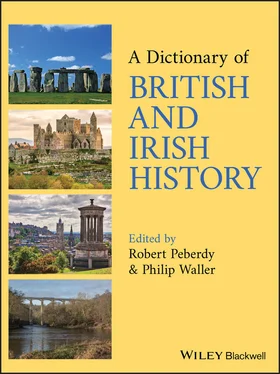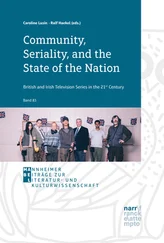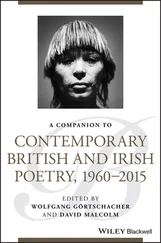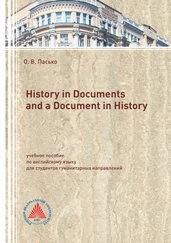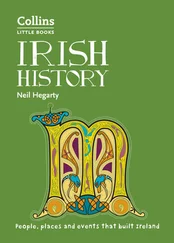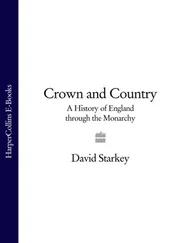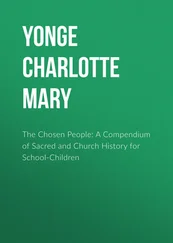BORDER, ANGLO‐WELSH
W Britain (WALES) was severed from direct land contact with other British areas by Germanic (English) kingdoms probably in the early 7th century. Soon afterwards, the advance of the English kingdom of MERCIA against the Welsh kingdom of POWYS pushed the border back to a N–S line between the Dee and Severn estuaries, which was roughly marked from the late 8th century by OFFA'S DYKE. For over 400 years, political and settlement borders fluctuated around that axis (from the mid 10th century dividing the Welsh kingdoms from a united England).
English settlement moved W even after construction of the dyke; English lived around Radnor (C Wales) by the late 10th century, and in NE Wales before 1066. Though NORMANS invaded Wales from the late 11th century, the lordships they founded, constituting the MARCH OF WALES, were treated as territories within Wales.
BORDER COMMISSIONSIn the 14th–16th centuries, disorder was endemic in the Anglo‐Scottish border country, with cross‐border raids for cattle thieving. After the UNION OF CROWNS (1603), both sides came under King JAMES VI/I, who appointed ten border commissioners (five Scots, five English) to administer justice (1605). By often brutal means, they largely pacified the area. The commission was renewed in 1618 but disbanded in 1621. Disorder revived, prompting CHARLES I to establish new commissions (1630, 1635). See also BORDER, ANGLO‐SCOTTISH; RAIDING, CROSS‐BORDER. BORNEO
An island in SE Asia within which Great Britain acquired territories. In 1842 the sultan of Brunei in N Borneo gave the Sarawak River area (later named Kuching) to the Englishman James Brooke, inaugurating rule by members of the BROOKE FAMILY (to 1946). It was extended by further grants between 1846 and 1905. The territory was known as Sarawak.
In 1880 the Englishman Alfred Dent acquired an existing foreign jurisdiction in part of NE Borneo, called North Borneo. It was governed from 1882 by Dent’s BRITISH NORTH BORNEO COMPANY.
Both territories, together with Brunei, were made British PROTECTORATES in 1888. Timber and rubber were exported. Approx. total population in 1921: 1,846,000. Sarawak and Brunei were occupied by Japan 1941–5, North Borneo 1942–5. Sarawak and North Borneo became CROWN COLONIES in 1946, and joined the Federation of Malaysia in 1963, when British forces helped to defend them from Indonesia. (North Borneo was renamed Sabah.) Brunei was granted internal self‐government in 1971 and independence as a sultanate in 1983.
BOROUGH
A settlement, usually a TOWN, where some inhabitants enjoy particular rights, privileges or liberties. Some were personal, such as the right to sell or bequeath property; others were corporate, such as the right to elect officers and administer the town. The term is derived from OE burh , which originally referred to a fortified centre.
By the mid 11th century, larger BURHS (in England) probably had courts and customs. During the 12th and 13th centuries, kings granted charters of liberties to many English towns, especially larger ones, often including confirmation of existing customs and self‐government (e.g., to OXFORD, c .1155). Lords also founded, and granted varying liberties to, numerous small towns (e.g., Maurice de Gant to LEEDS, 1207), which historians sometimes designate as ‘seigneurial boroughs’. From the 13th century, some boroughs were represented in PARLIAMENT, and are often designated ‘parliamentary boroughs’ by historians. Boroughs sometimes received extensive legal rights from the mid 14th century and are regarded as ‘incorporated boroughs’, while from the late 14th century a few towns received county status, becoming ‘county boroughs’ ( see INCORPORATION OF BOROUGHS). Kings and lords created boroughs in Wales (from late 11th century) and Ireland (from late 12th century), following invasions; similar developments occurred in Scotland ( see BURGH).
The organization of TOWN GOVERNMENT – including the holding and definition of borough status and borough FRANCHISES – was controlled from the 19th century by the UK Parliament, and also from the 1920s by the parliaments in Ireland. See also GUILD; ROTTEN BOROUGH; LOCAL GOVERNMENT, NORTHERN IRELAND/SOUTHERN IRELAND.
BOSTON TEA PARTYA protest at Boston, MASSACHUSETTS (N America), on 16 Dec. 1773 when men disguised as Indians threw 342 chests of tea from three ships into the harbour. They were objecting to the British Tea Act (1773), which permitted the EAST INDIA COMPANY to send tea directly to British colonies. The Act threatened local mercantile interests because the Company’s tea would undercut their trade. The British Parliament responded with the INTOLERABLE ACTS. See also AMERICAN INDEPENDENCE, ORIGINS OF. BOSWORTH, BATTLE OFFought on 22 Aug. 1485 about 3 mi (5 km) SW of Market Bosworth (Leicestershire, C England), between armies supporting King RICHARD III (YORKIST) and Henry Tudor, claimant to the throne (LANCASTRIAN). Richard was defeated and killed when Lord Stanley (Henry’s step‐father) and his brother Sir William Stanley intervened on Henry’s side. Henry succeeded as king (see HENRY VII). See also YORKIST–LANCASTRIAN CONFLICT; BEAUFORT, MARGARET; STANLEY FAMILY. BOTANY BAYAn inlet in SE Australia, on the coast of NEW SOUTH WALES, which was the original landing site in AUSTRALIA of James COOK (29 April 1770). Cook applied the name because of the diverse flora. It became associated with the TRANSPORTATION of British and Irish convicts, who first arrived there on 18 Jan. 1788, though the penal settlement was established at Sydney. BOTHA, LOUIS
(b. 27 Sept. 1862 near Greytown, Natal; d. 27 Aug. 1919 at Pretoria, Transvaal, South Africa, aged 56). A Boer farmer, Botha was elected to the Parliament of Transvaal (or South African Republic) in 1897. During the (Second) BOER WAR he became commander‐in‐chief of Transvaal forces (1900), but in May 1902 advised peace making.
When Transvaal (now a British CROWN COLONY) was granted self‐government (1907), Botha became prime minister. He supported the proposed federal SOUTH AFRICA and served as its first prime minister (1910–19). During WORLD WAR I he suppressed the pro‐German Maritz Rebellion (1914–15) and occupied German South West Africa (1915, modern Namibia). Botha’s assertion of South African influence within the BRITISH EMPIRE alienated many Boers. See also SMUTS, JAN.
BOTHWELL, 4TH EARL OF(b. 1534 or 1535 in Scotland; d. 14 April 1578 at Drachsholm, Denmark, aged about 43). James Hepburn inherited his earldom in 1556. Although he adopted Protestantism before the REFORMATION (1560), he remained pro‐French and supported the Catholic MARY OF GUISE (regent 1554–9) and MARY, QUEEN OF SCOTS. He was suspected of involvement in the murder of her (second) husband, Lord DARNLEY (10 Feb. 1567). He then divorced his wife and married Mary (15 May 1567) but his enemies forced Mary to abandon him (and to abdicate). Bothwell fled to Orkney, then to Denmark where he died in prison. See also CONFEDERATE LORDS. BOTHWELL, 5TH EARL OF(b. Dec. 1562; d. April 1612 at Naples, Kingdom of Naples, aged 49). Francis Stewart, a grandson of King JAMES V, was recognized as earl of Bothwell in Nov. 1577, succeeding his uncle the 4th earl before his death. He rose to prominence following the RUTHVEN RAID (22 Aug. 1582). His pro‐English beliefs faltered after the execution of MARY, QUEEN OF SCOTS (Feb. 1587), and he rebelled alongside the northern earls in April 1589. Appointed assistant governor during JAMES VI's absence abroad (1589–90), he retained royal confidence until implicated in witchcraft by the North Berwick witch trials (Nov. 1590; imprisoned April–June 1591). Thereafter he attempted to recover favour through a series of armed confrontations with James (1591–4). In March 1595, having lost Protestant support, he went into exile in Continental Europe. BOTHWELL BRIG, BATTLE OFFought near Hamilton (S Scotland) on 22 June 1679. A Scottish government force, commanded by the duke of MONMOUTH, routed an army of COVENANTERS, killing 200–400 men. The battle was the culmination of the RISING OF 1679. Thereafter, support for Covenanting waned, leaving the CAMERONIANS as the main group of radical Covenanters. BOTSWANAsee BECHUANALAND BOUDICCA(d. 61 in C Britain). The last queen of the Iceni, a British tribe whose territory (modern Norfolk, E England) was absorbed into the province of ROMAN BRITAIN on the death of her husband King Prasutagus (60 or 61). Flogged by the Romans, who also raped her daughters, Boudicca (also known as Boadicea) led a rebellion (61) while the Roman governor, C. Suetonius Paulinus, was campaigning in W Britain (Wales). The rebels sacked Camulodunum (COLCHESTER), Londinium (LONDON) and Verulamium (ST ALBANS) before being defeated in battle by Paulinus, after which Boudicca took poison. BOULTER, HUGH(b. 4 Jan. 1672 at London, England; d. 27 Sept. 1742 at Westminster, Middlesex, England, aged 70). In 1724 Boulter, a bishop in England, was appointed (Church of Ireland) archbishop of ARMAGH and primate to strengthen British influence in Ireland during the WOOD'S HALFPENCE AFFAIR. (He sat on the Irish COUNCIL and in the Irish House of Lords.) From 1730 (recall of Governor CARTERET), he was the British government's main adviser on Irish policies. He supported ANTI‐CATHOLIC LEGISLATION, opposed Protestant demands for legislative independence (see PATRIOTS), and recommended English candidates for government and Church posts. Boulter also promoted education and charities, and contributed to relief during the 1740–1 famine. See also PROTESTANT ASCENDANCY. BOULTON, MATTHEW
Читать дальше
